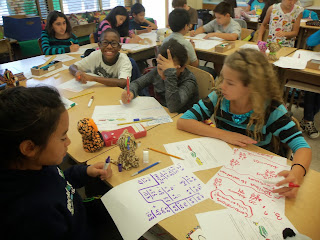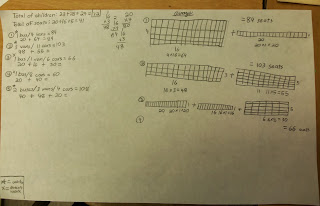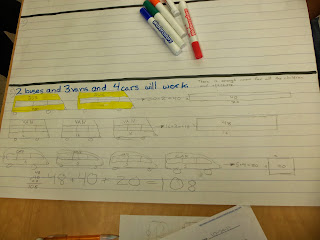4.NF.1
Explain why a fraction a/b is equivalent to a fraction (n × a)/(n × b) by using fraction models, with attention to how the number and size of the parts differ even though the two fractions themselves are the same size. Use this principle to recognize and generate equivalent fractions.See the Leapfrog problem.

This summer I had the wonderful opportunity to tutor my friend, Dylan. He wanted to better understand fractions, so I challenged him with this MARS Task assessment. After he read the directions, I helped him think of some problem-solving strategies. In order to find the answers, Dylan made a number line graph that helped him visually compare the various fractional parts. These included: halves, fourths, thirds, sixths, eighths, and ninths.
Using 1/2 inch graph paper, Dylan made number lines that were each 18 boxes long, so it was easy for him to make halves, thirds, sixths, and ninths. Then he figured out how to make fourths by cutting the halves in half.
Next, he was able to find the eighths by cutting the fourths in half.
In this way, he could easily compare some of the necessary equivalent fractions for this task.
Dylan said that Frog 1 was easy to solve. He just had to determine the missing fraction that made the equation add to one, and help the frog hop from the lily pad to the island.
So...
here is how Frog 1 hops to the island:
Dylan drew a double number line on his paper to compare halves and fourths for Frog 1.
With each step in the Leapfrog problem, Dylan was able to measure and compare the fractions on his number line graph with the fractions that were on the assessment.

Here is his solution for Frog 2:
This time Dylan's double number line compared thirds and sixths. You can also see how he helped the frog hop across the number line to solve for the missing fraction.


This is Dylan's solution for
Frog 3:
His double number line compares fifths and tenths. Notice that this time these fractions were not on his number line graph sheet, so he had to decide how to compare them. He colored in the 3/5 and 1/10, but then wasn't sure what to do. I marked the missing part and wrote a question mark.

Immediately, he saw the answer! "It's 3/10," he beamed. "Too easy!"
I was so proud of Dylan when he figured out how to make equal parts with fifths and tenths and compare these with the same one whole. Great job, Dylan!!
"That's terrific that you knew 6/8 was equal to 3/4," I smiled.
 "Grandma and I are so impressed!!
"Grandma and I are so impressed!!
But watch out for Frog 5," I continued.

Dylan saw that he had to add sixths and ninths, so he made another double number line and figured out how to make equal parts with each that represented the same whole.

Again, Dylan wasn't sure how to make the last hop to the island, so I showed him the missing portion on his number line and wrote another question mark.

Now for the "big enchilada"! Could Dylan figure out Frog 6 by himself? I quietly watched as he read the problem out loud, started drawing a double number line as before, when suddenly he stopped and put down his pencil. He thought for a moment and then realized that this time he needed to draw a third number line. First, he added 1/4, then 10/20....but when he highlighted the 1/5 with the orange marker he realized that it was just a little bit short of the island.

Here is his solution for Frog 2:
This time Dylan's double number line compared thirds and sixths. You can also see how he helped the frog hop across the number line to solve for the missing fraction.


This is Dylan's solution for
Frog 3:
His double number line compares fifths and tenths. Notice that this time these fractions were not on his number line graph sheet, so he had to decide how to compare them. He colored in the 3/5 and 1/10, but then wasn't sure what to do. I marked the missing part and wrote a question mark.

Immediately, he saw the answer! "It's 3/10," he beamed. "Too easy!"
I was so proud of Dylan when he figured out how to make equal parts with fifths and tenths and compare these with the same one whole. Great job, Dylan!!
"That's terrific that you knew 6/8 was equal to 3/4," I smiled.
 "Grandma and I are so impressed!!
"Grandma and I are so impressed!!But watch out for Frog 5," I continued.

Dylan saw that he had to add sixths and ninths, so he made another double number line and figured out how to make equal parts with each that represented the same whole.

Again, Dylan wasn't sure how to make the last hop to the island, so I showed him the missing portion on his number line and wrote another question mark.
Once more the eyes sparkled and he wrote "2/6 = 1/3."
Fabulous!

Now for the "big enchilada"! Could Dylan figure out Frog 6 by himself? I quietly watched as he read the problem out loud, started drawing a double number line as before, when suddenly he stopped and put down his pencil. He thought for a moment and then realized that this time he needed to draw a third number line. First, he added 1/4, then 10/20....but when he highlighted the 1/5 with the orange marker he realized that it was just a little bit short of the island.
Wow!! He did it! I reminded him that he had to use pictures, numbers, and words to prove his answer so he wrote, "no he will not make it because it is short." Way to go, Dylan!! Good job!!
Here are Frog 5 and Frog 6:
And the studious man hard at work...































































